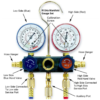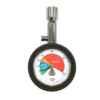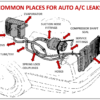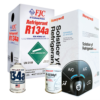Coolant? Refrigerant? What’s the Difference?
When you’re in the A/C business (like we are) the distinction between coolants (antifreeze) and refrigerants is abundantly clear. However, so many people ask us to distinguish between them that we’ve decided to set the record straight once and for all. While both systems utilize aspects of heat transfer, and both are involved in the heating, ventilation, and air conditioning system (HVAC) of a vehicle, the differences between coolant and refrigerant are significant.
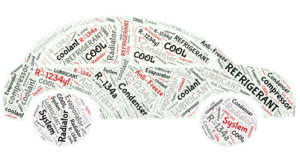
Let’s take a look:
COOLANT/ANTIFREEZE
Antifreeze is one of the components of a coolant mixture (coolant is generally a 50/50 mixture of antifreeze and water). Antifreeze is used to lower the freezing point and raise the boiling point of the liquid that circulates around the engine of a vehicle. This helps prevent the engine from freezing during cold weather. The coolant also keeps the internal parts of the engine lubricated so that they work smoothly. Antifreeze is either green or orange, and stays in liquid form.
- Engine coolant uses water to transfer the heat produced from the engine to air rushing through the radiator. It also transfers heat from the engine to the cabin when the heat function is being used.
- Antifreeze also contains rust inhibitors. These inhibitors do have a shelf life which is a serious concern for engine cooling systems, so it is necessary to replace the antifreeze and water from time to time.
- An engine coolant flush will NOT help your AC blow colder.
Summary: The objective of coolant is to keep the engine from freezing. It is a liquid comprised of anti-freeze and water. It is necessary to replace the coolant from time to time to protect your engine.
REFRIGERANT
A refrigerant is a substance or mixture used in an air conditioning system. It works in a cycle and undergoes phase transitions from liquid to gas and then back again based upon the pressure applied to it. These phase changes cause the refrigerant to absorb and release heat throughout the cycle. Today automobiles use either R-134a (which is being phased out) or R-1234yf refrigerants. Refrigerant has a very, very low boiling point.
- Air conditioning refrigerant is used to remove heat from the car’s cabin to outside the vehicle through the properties of evaporation.
- Throughout the air conditioning cycle, refrigerant will switch between a liquid and vapor state.
- The heart of the A/C system is the compressor. Since it has moving parts, it requires lubrication. Therefore, A/C compressor oil is mixed with the refrigerant as it travels through the system. The oil also helps protect against rust, eliminating the need for rust inhibitors.
- Since the A/C system is a closed system, ideally there would be no need to add more refrigerant. However, if the A/C stops blowing cold air, or if the vehicle is involved in a collision, there may be a leak in the system. FJC offers leak detection kits and stop leak products as well as a full line of refrigerants to recharge a system.
Summary: The objective of refrigerant is to cool the cabin of the vehicle for passenger comfort. The refrigerant and refrigerant oil is contained in a closed A/C system and changes phases throughout the process, absorbing and releasing heat as it goes.
LMK 2019


